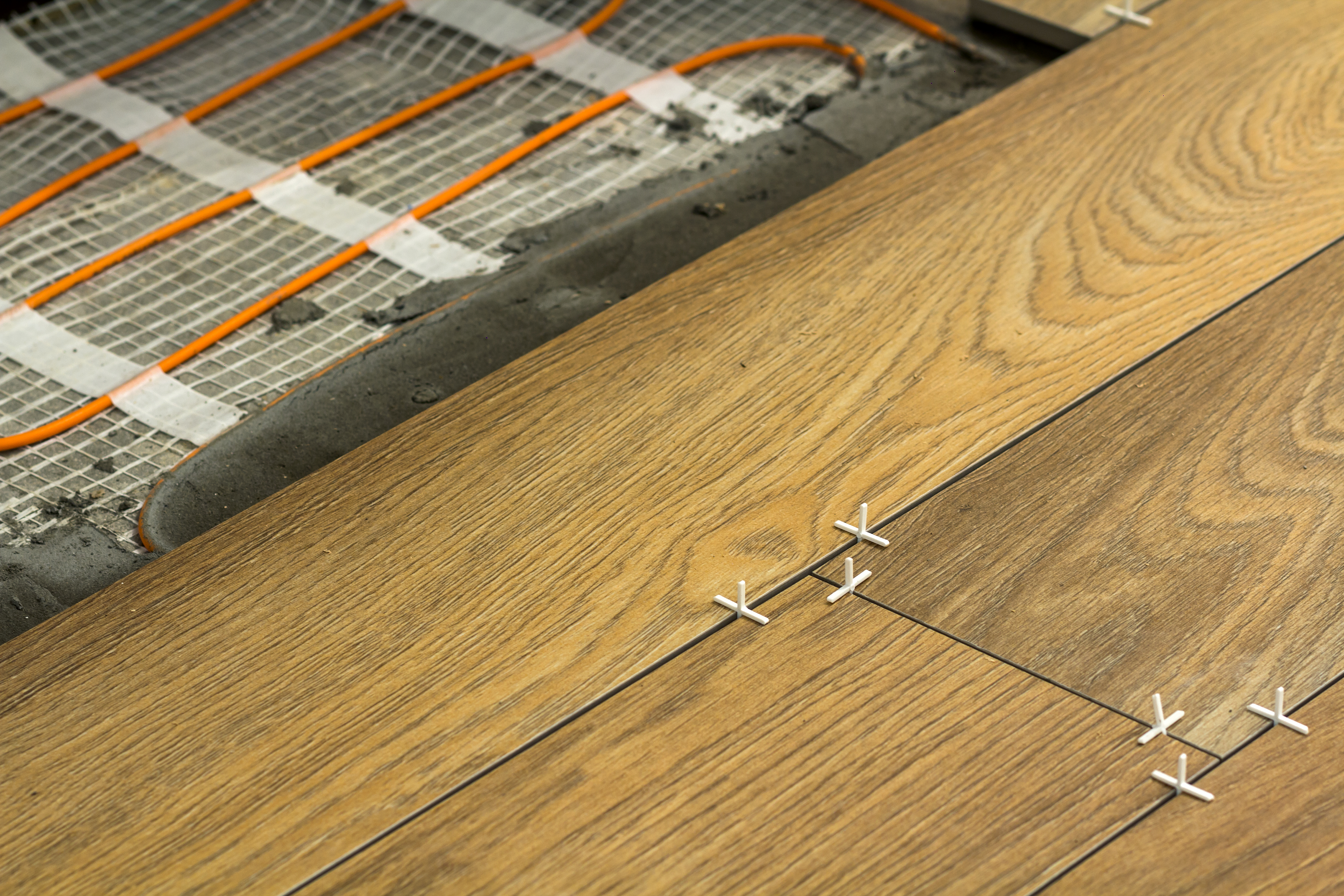
The flooring market of today presents a vast range of options for any space. Products can be found in all types of texture and colour, to suit any style or budget. Despite this seemingly endless amount of choice, however, care must still be taken to ensure that the optimum materials are selected. The situation of the installation is a vital consideration for any flooring choice, to ensure it is as effective as possible. This is particularly important for those areas that use underfloor heating.
The importance of heat transfer
The point of underfloor heating is to warm up the room from ground level. An underfloor heating system consists of pipes or wires installed within the floor, essentially transforming the entire floor area into a radiator. The mass of the floor becomes heated and that heat is transferred into the room. Utilising such a large surface area to transfer heat ensures that the system can operate at a lower temperature. This means that underfloor heating is often more energy efficient than standard central heating systems and can help to reduce household running costs.
The money-saving energy efficiency of an underfloor heating system is only achieved when flooring materials are selected to support the transfer of heat, however. The system can be operating in the optimal way, generating ideal temperatures at minimal cost, but if the flooring materials in the room fail to allow that heat to pass through, those savings and efficiencies are lost. For this reason, the thermal conductivity of materials is the main consideration when choosing flooring for use with underfloor heating. The higher the thermal conductivity of the flooring material, the more efficient the transfer of heat into the room.
Comparing flooring materials
Advances in modern flooring means that, even when heat transfer is a central consideration, there is still a wide range of options available. This allows the consumer to weigh the importance of thermal conductivity with style and budget.
- Carpet
Carpeted flooring and rugs can work well with underfloor heating, but only when the combination of underlay and carpet generate an overall tog value of 2.5 or less. When the total tog value exceeds 2.5, heat transfer is drastically reduced. This is because higher tog value carpet and underlay are designed for insulation, which specifically requires lower thermal conductivity.
- Wood
The thermal conductivity of wood flooring can be relatively high, depending on the type selected.
- Engineered wood – This usually boasts good structural stability which transfers heat efficiently. Engineered hardwood performs particularly well with underfloor heating systems.
- Solid hardwood and softwood – This can work well with underfloor heating when narrow boards are used. The thickness of boards should be specified to work with the level of heat output required from the underfloor heating system.
- Laminate
Whether the laminate is designed to look like wood or stone flooring, its multi-layer structure can provide good thermal conductivity within a hard-wearing product. A further benefit of the laminate structure is that it is less prone to warping caused by temperature fluctuation, meaning that it is a highly stable, reliable flooring option for use with underfloor heating.
- Screed and resin
Flooring consisting of polished screed or resin are essentially solid, sealed floors and, as such, work well with underfloor heating. These floors create a heat transfer that is particularly even, boosting the efficiency of the heating system. Moreover, screed operates as a thermal store which means that the flooring retains heat for longer. This makes the underfloor heating system highly efficient and more cost-effective.
- Vinyl
When teamed with underfloor heating, it is the thinness of vinyl flooring that provides the most benefit. A thin layer of foam is used to provide cushioning, with a layer of synthetic material laid over it. The result is a durable product that delivers stylish floor coverage while allowing efficient heat transfer from underfloor heating systems.
- Stone and ceramic
Stone and ceramic flooring, including tiles, are renowned for their high levels of thermal conductivity. These materials also feature good heat retention, making underfloor heating systems more efficient. It is still important to consider the thickness of the stone or ceramic products being used, though. While these materials conduct heat well, thicker tiles take longer to heat up, potentially slowing the process of warming a room. The right stone or ceramic flooring will ensure that the room is heated evenly and effectively, however.
Frequently Asked Questions
Q. Do I need to worry about flooring expanding and contracting due to the underfloor heating system?
A. The way in which materials react to temperature fluctuation varies, and this is certainly something to keep in mind while choosing flooring to use with an underfloor heating system. For example, solid wood can warp under particular circumstances, while tiles can develop cracks. These situations can be avoided by seeking expert advice about flooring options that support the level of heat output expected from your underfloor heating system, as well as having flooring professionally installed. This will ensure that materials are handled properly, acclimatised as necessary, and fitted in such a way as to prevent movement and damage as far as possible.
Q. Can my flooring be laid immediately after fitting an underfloor heating system?
A. There is no single answer to this question as it depends entirely upon both the choice of underfloor heating system, and the choice of flooring. Dry flooring can be fitted over dry underfloor heating systems straight away. However, screed or resin flooring requires a lengthy time period in which to fully cure, and this must be taken into consideration when planning the project.
Q. Can I turn the underfloor heating on as soon as my flooring is installed?
A. Sudden changes in temperature can have an adverse effect on any flooring material, even when it has been professionally handled and installed. It is therefore essential to follow the advice of experts and, when you do turn the underfloor heating on, you should allow the system to heat very slowly for its initial operation. Every type of material will respond differently, but gradually heating the floor at first will help to protect your flooring from damage.
Need further advice?
If you need help deciding which flooring is best for you if you have underfloor heating installed or are planning to have it installed before installing new flooring, then Flooring Superstore boasts a highly trained team of experts delivering a wealth of experience in different types of flooring. With free samples, fast delivery, and an excellent Trustpilot rating, you can trust us to help you find what you need.
Use our contact form on our website or alternatively call one of our friendly and expert team on 03308 182 500.












